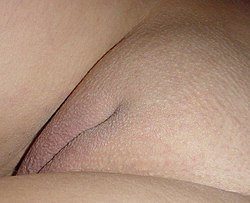| Revision as of 21:28, 7 September 2014 editNipplewoman (talk | contribs)15 edits Incorrect representation of labia majoraTags: Mobile edit Mobile web edit← Previous edit | Revision as of 21:30, 7 September 2014 edit undoFlyer22 Frozen (talk | contribs)365,630 edits Undid revision 624587676 by Nipplewoman (talk) In what way?Next edit → | ||
| Line 8: | Line 8: | ||
| | Caption = Outer anatomy of the vagina. | | Caption = Outer anatomy of the vagina. | ||
| | Width = | | Width = | ||
| | Image2 = | | Image2 = Labia Majora.jpg | ||
| | Caption2 = Labia majora and pudendal cleft | | Caption2 = Labia majora and pudendal cleft | ||
| | ImageMap = | | ImageMap = | ||
Revision as of 21:30, 7 September 2014
| It has been suggested that Posterior commissure of labia majora be merged into this article. (Discuss) Proposed since March 2014. |
| Labia majora | |
|---|---|
 Labia majora and pudendal cleft Labia majora and pudendal cleft | |
| Details | |
| Precursor | Genital swelling |
| Artery | Deep external pudendal artery |
| Nerve | Perineal branches of posterior femoral cutaneous nerve |
| Identifiers | |
| Latin | labium majus pudendi |
| TA98 | A09.2.01.003 |
| TA2 | 3549 |
| FMA | 20367 |
| Anatomical terminology[edit on Wikidata] | |

The labia majora (singular: labium majus) are two prominent longitudinal cutaneous folds that extend downward and backward from the mons pubis to the perineum. The labia majora is homologous to the male scrotum.
Embryology
Embryologically, they develop from labioscrotal folds.
Anatomy
The labia majora constitute the lateral boundaries of the pudendal cleft, which contains the labia minora, interlabial sulci, clitoral hood, clitoral glans, frenulum clitoridis, the Hart's Line, and the vulval vestibule, which contains the external openings of the urethra and the vagina. Each labium majus has two surfaces, an outer, pigmented and covered with strong, crisp hairs; and an inner, smooth and beset with large sebaceous follicles. Between the two there is a considerable quantity of areolar tissue, fat, and a tissue resembling the dartos tunic of the scrotum, besides vessels, nerves, and glands. The labia majora are thicker in front, where they form by their meeting the anterior commisure of the labia majora. Posteriorly, they are not really joined, but appear to become lost in the neighboring integument, ending close to, and nearly parallel to, each other. Together with the connecting skin between them, they form the posterior commisure of the labia majora or posterior boundary of the pudendum. The interval between the posterior commissure of the labia majora and the anus, from 2.5 to 3 cm. in length, constitutes the perineum. Between the labia majora and the inner thighs are the labiocrural folds. Between the labia majora and labia minora are the interlabial sulci. Labia majora atrophy after menopause.
Use in grafting
The fat pad of the labia majora can be used as a graft, often as a so-called "Martius labial fat pad graft", and can be used, for example, in urethrolysis.
See also
References
- Manual of Obstetrics. (3rd ed.). Elsevier. pp. 1-16. ISBN 9788131225561.
- Attention: This template ({{cite doi}}) is deprecated. To cite the publication identified by doi:10.1016/S0090-4295(03)00117-1, please use {{cite journal}} (if it was published in a bona fide academic journal, otherwise {{cite report}} with
|doi=10.1016/S0090-4295(03)00117-1instead.
External links
![]() This article incorporates text in the public domain from page 1265 of the 20th edition of Gray's Anatomy (1918)
This article incorporates text in the public domain from page 1265 of the 20th edition of Gray's Anatomy (1918)
Lua error in Module:Navbox at line 535: attempt to get length of local 'arg' (a number value).
Categories: